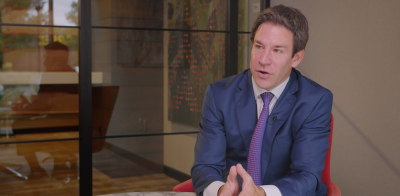If rational (or at least semi-rational) investors were looking for another reason to focus on seeking to protect capital, savor consistent mid to high single-digit income and/or total return streams like a fine Loire Valley Pouilly Fume or Burgundian Chardonnay, and embrace alternatives in the northwest quadrant of the efficient frontier1 (besides all of the topics we have discussed during the past 18 months—money supply shrinking, Fed still hiking, recession risk escalating, etc. and the more recent potential for a debt ceiling debacle), well, they have one now: Old-fashioned bank runs and failures. Who knew historically “risk-free” assets could cause such a problem?
- As I have discussed in multiple strategy notes and the M22 white paper written in September 2021, Fed tightening cycles don’t go well and bad things usually (or should I say always) happen. When you throw quantitative tightening (QT)3 into the mix, the pace and magnitude of those bad things can be exacerbated. And man, it didn’t take much quantitative tightening or that much time for the weakest links of the financial system to be exposed: Only 7% balance sheet reduction and a whopping 2% decline in money supply (granted the Fed did invert the yield curve to the greatest levels since the early 1980s)!
- Up until the recent failure of Silicon Valley Bank (SVB), those bad things have mainly been limited to asset value implosions in 60/40 asset allocation (both beta and duration4 getting simultaneously annihilated), go-go growth, biotech, crypto, etc. All of these had been relatively benign reversals of excessive asset inflation as the Galactic Mean Reversion rolled on and has not been terribly troubling particularly for those who have embraced democratized alternatives.
- Despite my urgings, inertia was, and still can be, a powerful obstacle for better optimizing portfolios for a quantitative tightening world (Man, the old “I don’t want to pay that much in taxes” excuse looks worse by the day, particularly from tech guys). If old-fashioned bank runs and failures do not provide the impetus for investors to fight inertia and win, I don’t know what will.
- I won’t get into a blame game, but this is unfortunately one of the economic and human tolls of continuing quantitative easing5 for way too long, ludicrously embracing “inflation is transitory” for misguided economic and political reasons for way too long, and then jamming on the brakes as hard as possible to crush an inflation problem that has fully spread to labor and services.
- However, fortunately at the time of writing this note, it looks like a deeper crisis of cascading bank failures should be averted since the Fed will backstop financial system liquidity in totality and deposits of all sizes will be guaranteed by the U.S. Treasury.
- Unsurprisingly, deciphering the forward trajectory of monetary policy and the economy will only get harder in short term—which, of course means, more uncertainty and volatility. Is quantitative tightening over now or will the Fed continue to drain their balance sheet, hike rates, and shrink money supply while backstopping bank liquidity with the Treasury and FDIC backstopping any depositor losses during the continued fight against inflation? Does this exacerbate current service inflation and provide additional impetus to the Galactic Mean Reversion as economic actors continue to shun financial assets in favor of real-world living? Will the additional “turbulence” in growth sectors of the U.S. economy spill over to services sufficiently to cool service ex-shelter and wage inflation?
- With regard to SVB’s failure specifically and the broader banking system, the similarities and differences between bank failures during the Great Financial Crisis are both striking:
Similarities:
a. Bank(s) were/are long a bunch of assets that dropped substantially in value and could drop even more in value.
b. Prior to solvency questions emerging, banks grew their assets at a more rapid pace than usual.
c. Both sets of problem assets were acquired partially with government blessing and encouragement. Prior to the Global Financial Crisis, the motivation was to help increase homeownership. This time around it was to help fund government deficits by assigning very low risk charges for government or government guaranteed debt.
d. Despite assurances to the contrary, the solvency of the bank(s) comes into question as potential losses could potentially exceed Tier 1 equity capital6.
e. Depositors start freaking out and withdraw their savings and the liquidity of the bank is exhausted.
f. Bank fails, FDIC steps in, eventually Treasury and Fed steps in.
Differences:
a. During the Global Financial Crisis, the assets that had dropped substantially in value were CREDIT assets principally tied to residential real estate (RMBS). This time around, the assets are government guaranteed long DURATION4 Treasuries that dropped in value because interest rates have gone up a lot. This is not a credit crisis but a duration crisis!
b. Said a different way, the Global Financial Crisis started as a real estate credit problem and financial institutions with too much subprime mortgage loan exposure failing. The current situation started as a duration4 problem and financial institutions that had too much long duration4 exposure and a fragile, flighty go-go growth/venture capital customer base failed (which by the way, are very long duration as well).
c. Going into this bear market, real estate loan underwriting standards were still tight and the real estate ecosystem was still cautious because it was way too soon to forget the Global Financial Crisis. However, any and all growth investor and ecosystem risk aversion was non-existent because it had been just long enough to forget the dotcom bubble implosion. Going into the Global Financial Crisis, it was the opposite—equity investors were still cautious and the real estate ecosystem was out of control.
d. The banking system—including systemically important banks or “too big to fail” —still has around 50% more Tier 1 capital6 as a percent of risk weighted assets than prior to the Global Financial Crisis even after the long duration asset decimation of 2022.
e. Despite deposits fleeing banks to take advantage of higher interest rates in money market funds courtesy of the Fed’s reverse repo facility and into short, dated Treasuries the past 15 months, the U.S. banking system still has over $3 trillion in excess reserves which dwarfs the $10 billion coming into the Global Financial Crisis.
f. It took the Treasury, Fed and FDIC over two years to come up with a muscular enough policy response to stem the Global Financial Crisis. This time, it took 72 to 96 hours (we hope).
8. Silicon Valley Bank’s outcome is yet another extension of my master thesis that “Cash Flow is King” in this environment. It turns out this is not only important for investors when determining which strategy and security investments to make in this market environment, but also for bank CEO’s and risk officers in determining what type of clients to focus on! When your business has little or no cash flow and you can’t raise capital, you have no choice but to aggressively draw down deposits. If your entire banking client base has little to no cash flow….well, here comes the FDIC.
9. Despite what will almost certainly be another round of volatility for equity markets and growth investors (how many times have we heard “this time is different than the dotcom bubble” from those guys…yeah, you’re right, we didn’t have the 16th largest bank focused almost exclusively on growth companies fail back then), the RIGHT alternatives are still doing what they are supposed to do and in a complete reversal of last year, so are bonds, particularly shorter dated bonds! Additionally, the probability of the Fed going above 5% to 5.25% with the Fed Funds rate having now dropped dramatically, as has the likelihood they drain the balance sheet by 35% from the peak and keep money supply shrinking for the next several years. It is doubtful that money supply grows faster than nominal GDP anytime soon (so hold your horses on any sustainable risk-on period), but at least it’s probably not going to shrink at the greatest pace since the Great Depression anymore.
10. Every bear market, mini crisis and crisis creates opportunities. And oh baby, is this latest sad saga going to create even more opportunities for liquidity providers and strategies that have potential to take advantage of volatility. After all, you don’t have to be a rocket scientist to figure out that a banking system already in retreat will be even more constrained in their lending. You don’t have to be a Venture Capital Wunderkind (apologies for the cheap shot) to figure out that early stage growth companies are going to have an even more challenging time raising capital. And you don’t need a PhD in Chemical Engineering to know that volatility will remain elevated for even longer now, particularly surrounding interest rates.
11. Here are some tangible examples of investment ideas and strategies that may benefit from the previous phenomena:
a. CRE Lending. Does anybody think banks are going to be rushing to grow their commercial real estate loan books and loosen their lending terms anytime soon? Au contraire, mon ami/amie…here come even more large rolling loan opportunities on trophy real estate and industrial properties.
b. Private Corporate Lending. Does anybody want to take the other side of a bet that private corporate lenders continue to take market share from banks? Here come larger loan opportunities to more resilient companies at wider spreads with higher floors
c. Growth Stage/Venture Capital Lending. Oh, my goodness, both the willingness and necessity for growth companies to borrow at even higher interest rates to grow their customer base just expanded dramatically! Perhaps lending rates for viable growth companies seeking to expand their market will breach 20% in this environment?
d. Volatility Driven Trading. Do you think multi-strategy funds that have been taking advantage of massive levels of interest rate volatility and inverted yield curves will run out of trade opportunities next week? Do you think tactical asset allocation strategies that have been trading around the yield curve and agency mortgage spreads will be out of ideas anytime soon?
e. Private Equity Secondaries. This one is admittedly more of a stretch, but the probability of a greater supply of cash strapped private equity owners who need liquidity fast just increased (or so one would think).
So keep calm and carry on because the Time for the RIGHT ALTS is Still Now!
Investing in alternatives is different than investing in traditional investments such as stocks and bonds. Alternatives tend to be illiquid and highly specialized. In the context of alternative investments, higher returns may be accompanied by increased risk and, like any investment, the possibility of an investment loss. Investments made in alternatives may be less liquid and harder to value than investments made in large, publicly traded corporations. When building a portfolio that includes alternative investments, financial professionals and their investors should first consider an individual’s financial objectives. Investment constraints such as risk tolerance, liquidity needs and investment time horizon should be determined.



